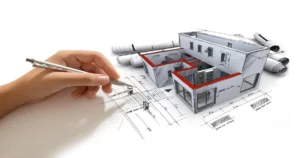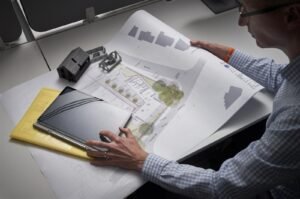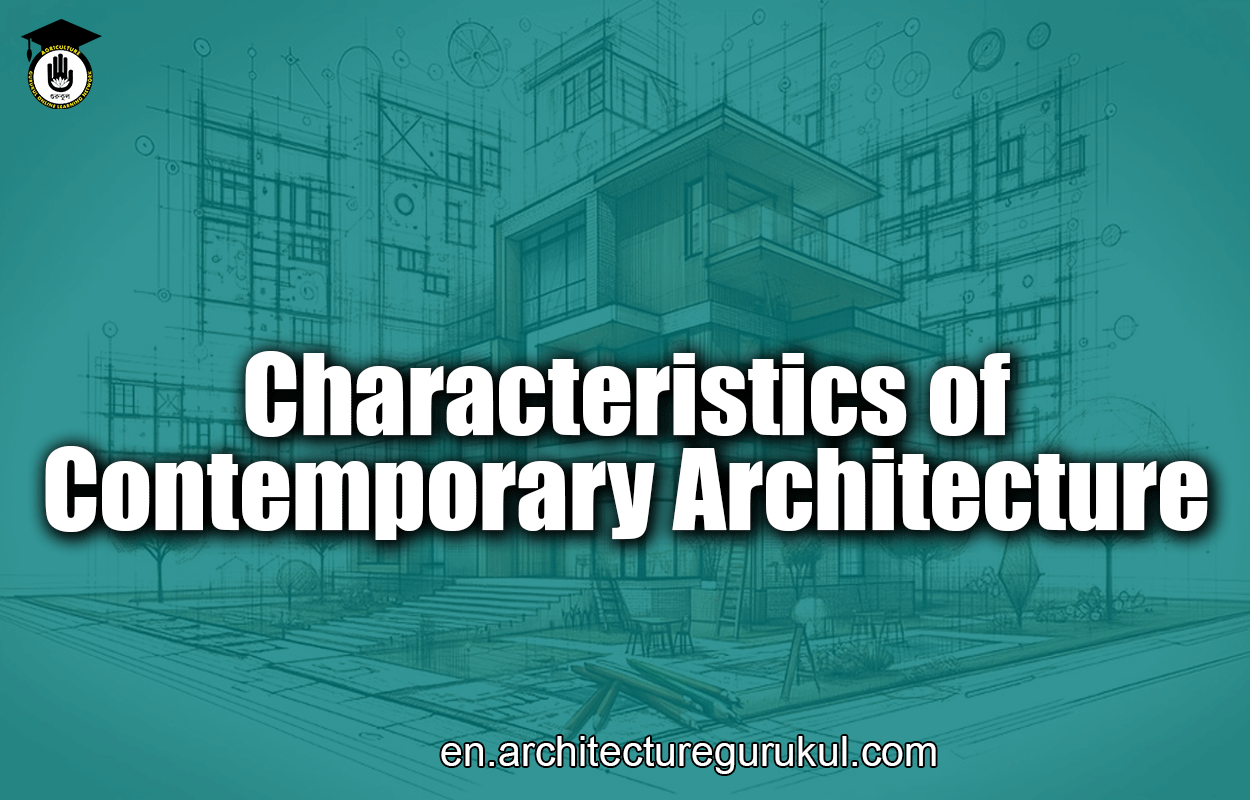Characteristics of Contemporary Architecture. Contemporary architecture represents the cutting edge of design and building practices in today’s world. Unlike historical architectural styles that are defined by specific periods or cultural contexts, contemporary architecture is dynamic and ever-evolving, reflecting the current trends, technologies, and societal needs. This article delves into the key characteristics of contemporary architecture, illustrating how this style embraces modernity and innovation while addressing environmental and functional concerns.

Characteristics of Contemporary Architecture
Key Characteristics of Contemporary Architecture
1. Innovative Use of Materials
Contemporary architecture is distinguished by its creative use of materials. Modern architects often employ new and unconventional materials to push the boundaries of design. For instance, advanced composites, glass, steel, and concrete are frequently used to achieve sleek, minimalistic looks. The use of transparent materials, such as glass, allows for an abundance of natural light, blurring the boundaries between indoor and outdoor spaces.
Examples:
– The Glass Pavilion in California by Steve Hermann, which showcases a full glass façade to merge seamlessly with its surroundings.
– The Eden Project in the UK, featuring geodesic domes made from ETFE, a lightweight and durable material.
2. Emphasis on Natural Light and Ventilation
Contemporary buildings often prioritize natural light and ventilation to enhance the indoor environment and reduce reliance on artificial lighting and climate control systems. Large windows, skylights, and open floor plans are designed to maximize light penetration and air circulation.
Examples:
– The Fallingwater House by Frank Lloyd Wright, which integrates large windows and cantilevered terraces to harmonize with the natural landscape.
– The Salk Institute in California by Louis Kahn, which uses expansive glass walls to allow for an abundance of natural light and views of the surrounding environment.
3. Minimalist Design and Clean Lines
A hallmark of contemporary architecture is its minimalist approach, characterized by clean lines, simple forms, and a lack of ornamentation. This design philosophy focuses on functional beauty and strives to eliminate unnecessary elements, creating spaces that are both elegant and practical.
Examples:
– The Barcelona Pavilion by Mies van der Rohe, known for its minimalist design and use of luxurious materials.
– The Villa Savoye by Le Corbusier, which epitomizes the minimalist approach with its straightforward geometric forms and open-plan layout.
4. Sustainability and Eco-Friendly Practices
Sustainability is a crucial aspect of contemporary architecture. Modern architects are increasingly incorporating eco-friendly practices and sustainable technologies to reduce environmental impact. This includes the use of energy-efficient systems, sustainable materials, and innovative green building techniques.
Examples:
– The Edge in Amsterdam, a highly energy-efficient office building with advanced sustainability features such as solar panels and rainwater harvesting.
– One Central Park in Sydney, which features green roofs and vertical gardens to enhance environmental sustainability.
5. Integration with the Environment
Contemporary architecture often emphasizes harmony with the natural environment. This involves designing buildings that complement their surroundings and making use of natural topography and climate. The goal is to create structures that are visually and functionally in tune with their context.
Examples:
– The Kauffman Center for the Performing Arts in Kansas City, which integrates with its urban surroundings while offering a striking modern aesthetic.
– The Casa Batlló in Barcelona by Antoni Gaudí, which harmoniously blends with the surrounding environment through its organic, nature-inspired design.
6. Flexible and Open Spaces
Contemporary architecture embraces flexible and adaptable spaces that can serve multiple functions. Open floor plans and modular designs are common, allowing for easy reconfiguration of spaces to meet changing needs. This flexibility enhances the usability and functionality of modern buildings.
Examples:
– The Tate Modern in London, a former power station converted into a flexible museum space with adaptable galleries.
– The High Line in New York City, an elevated park that reuses an old railway line and provides a versatile space for various public activities.
7. Technological Integration
Technology plays a significant role in contemporary architecture, with architects using advanced tools and methods to design and construct buildings. This includes the use of computer-aided design (CAD), 3D modeling, and building information modeling (BIM) to enhance precision and creativity in the design process.
Examples:
– The Burj Khalifa in Dubai, which employs advanced engineering and technology to achieve its record-breaking height.
– The Guggenheim Museum in Bilbao by Frank Gehry, known for its complex and innovative use of technology to create its unique forms.

Challenges and Criticisms
While contemporary architecture offers numerous benefits, it also faces several challenges and criticisms:
1. Cost and Complexity
The use of cutting-edge materials and technologies can result in higher construction costs. Additionally, complex designs may require more specialized skills and longer construction times, which can impact the overall feasibility of projects.
2. Contextual Sensitivity
Some critics argue that contemporary architecture can sometimes appear out of place in historic or culturally significant areas. The emphasis on modernity and innovation may clash with traditional architectural styles and local context.
3. Sustainability vs. Aesthetics
Balancing aesthetic appeal with sustainability can be challenging. While many contemporary designs prioritize environmental considerations, achieving both high performance and striking visuals requires careful planning and integration.

Contemporary architecture represents a dynamic and innovative approach to building design, characterized by its use of new materials, emphasis on natural light, minimalist aesthetics, and sustainability. By embracing modern technologies and addressing environmental and functional concerns, contemporary architecture continues to shape the built environment in exciting and meaningful ways. As design practices evolve, contemporary architecture will undoubtedly keep pushing boundaries, offering fresh perspectives and solutions for the challenges of the future.
Read More:
